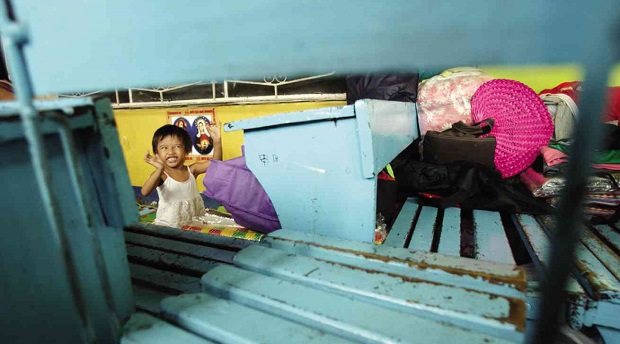
A WORKER chops newly harvested sugarcane stalks in Barangay Mabilog, Concepcion town, Tarlac province, in Hacienda Luisita, an estate owned by relatives of President Aquino. LYN RILLON
The payment that relatives of President Benigno Aquino received from the government for some 4,000 hectares of Hacienda Luisita, a 6,000-ha plus sugar estate that they own in Tarlac province, is based on prices in 1989, the year of reckoning that the Supreme Court set in its order to distribute the estate to beneficiaries of the Comprehensive Agrarian Reform Program.
The Department of Agrarian Reform (DAR) made this statement in its denial of allegations that the Cojuangco family was overpaid by as much as P167 million for portions of Luisita that have been marked for distribution to farmers.
“In its final decision … the Supreme Court ruled that 1989 would be the date of taking of the landholding,” said Agrarian Reform Undersecretary for Legal Affairs Anthony Parungao in a statement released by the DAR. “Meaning therefore that should be the reckoning point of the determination of the land’s valuation and the amount of just compensation,” he said.
On Friday, a party-list group representative said the Cojuangcos were overpaid by P167.5 million when the government shelled out P471.5 million to acquire 4,500 hectares of Luisita.
Public funds, said Rep. Antonio Tinio of ACT Teachers, were used to “further enrich” the President’s relatives.
He said the P167.5 million represented payment for interest, which should never have been paid at all.
But Parungao, in the DAR statement, said the land was deemed to have been taken by the government in 1989 and agrarian reform, or AR, bonds that are supposed to form part of the payment to the Cojuangcos earned interest during their 10-year maturity period until 1999.
“The P167 million is the accrued interest of the bonds for the said period. No interest was paid on the AR bonds after 1999,” Parungao said.
Per Land Bank of the Philippines’ (LBP) computation, the government valued Luisita lands at P67,550 per hectare. “If the interest on the AR bonds is factored in, the price the government is paying for Hacienda Luisita land is P104,759.52,” Parungao said.
Hacienda Luisita Inc. (HLI), a firm owned by the Cojuangcos, also said there was no overpayment. “Like any landowner whose land has been subjected to agrarian reform, [HLI] has the right, under social justice, to seek proper and just compensation,” said Antonio Ligon, HLI spokesperson, in an e-mail.
HLI, said Ligon, has no role in how the government-run LBP determined the value of Luisita land.
“[The year] 1989 was the reckoning year that the Supreme Court pegged when the land should have been distributed to the farm worker-beneficiaries,” Ligon said.
“Hence, HLI should have received the just compensation in 1989 but this was only released to HLI by LBP in 2013. Interest was rightfully applied by LBP on the bonds payment,” he said.
The President’s grandfather, Jose Cojuangco Sr., bought the estate and its sugar mill in 1957 using a government loan and guarantee.
But Tinio said the payment to the Cojuangcos was made “more outrageous” because they are the President’s relatives. “The excess payment must be recovered from the Cojuangcos in the name of social justice and for the sake of all taxpayers,” said Tinio.
The militant Kilusang Magbubukid ng Pilipinas (KMP) called as “brazen fraud and plunder” the payment of
P471 million to the Cojuangcos and asked the President’s relatives to return the money to the government.
On Friday, the KMP chapter Alyansa ng mga Manggagawang Bukid sa Asyenda Luisita (Ambala) reported that the Cojuangcos continued to bulldoze farms within a 358-ha area that the DAR recently placed under agrarian reform.
This happened although a court has dismissed an ejectment case against farm workers, Ambala chair Florida Sibayan said in a statement.